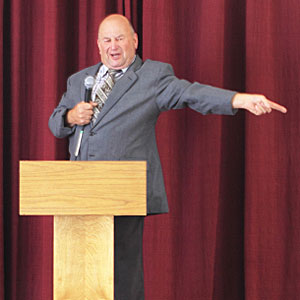How many times have you wondered if anybody was really listening or cared about what you were saying when giving a presentation? Obviously, the goal is to be heard by your listeners, yet, are there ways you can be sure? Yes and here is how and what the experts do!
- Ask. It’s so simple, but very few people take the time to check in with their audience. Periodically pause and ask your listeners rhetorical or open-ended questions such as, “Do you agree?” “Have you seen this also?” “What issues do you see?” A variety of open-ended and rhetorical questions take people from being passive to being more attentive.
- Look them in the eye. Sustained eye contact cannot be ignored. Avoid scanning. Look at one person at a time for a full sentence or thought. When you do, you will get some sort of reaction from the listener. The individual will smile, nod or demonstrate through their body language that they are listening.
- Move closer. If you come into the audience, people feel you have something important to say. You connect with them. You have nothing to hide. Your proximity makes them set aside their phones, laptops or tablets and listen up!
- Turn up the volume. Louder voices are taken more seriously. Softer voices lull people to sleep, and a monotone really annoys them. An interesting voice with lots of highs and lows commands attention.
- Amplify your energy. Go bigger with your gestures than seems comfortable to you. Let the energy flow from your face and hands. If you have a big point, let your audience see it. They will respond to your enthusiasm for your topic.
- Tell them a good story. A personal story with a business point always draws people in. They envision what you say and maybe even connect it to their own lives. As you think of the story you want to tell, decide on what details to include or exclude to make the story poignant or powerful.
- Site relevant examples. If the example is compelling, you win people over. You influence them and make them see your point.
- Put numbers into context. Statistics come alive when you show what they mean to the whole scheme of things. “We will save 4% in the next year or 5.4 million dollars. Steve Jobs once talked about the capacity of an iPod by saying, “Imagine a thousand songs in your pocket.”
- Speak in short, pithy statements. Do not drone on. Say what you need to say in the fewest words possible. Use strong descriptive adjectives and adverbs. Show criticality.
- Educate the uneducated with analogies. When a subject is over people’s heads, attention drifts. However, with the use of simple analogies, you can get people on the same page very quickly.
- Season your topic with humorous asides. Everyone responds to humor, but most speakers think it is too risky. Listeners love humor when it is appropriate. It re-invigorates the dreariest of topics.
Speaking would not so difficult if we could be assured our listeners were paying attention. Do not make the mistake of thinking your words alone will make people listen. About every four or five minutes, we need to change things. Do something different. The best speakers incorporate all of the above suggestions as often as they can in any one talk.
Question: How do you know whether your audience is listening? What additional tips can you share? We’re interested in your reaction to this article.
To add your comments click in the “Comment” box below and begin writing. Any questions will be answered by Judy.
Impact Communications, Inc. consults with individuals and businesses to improve their presentation and telephone communication skills. It is not what you know but how you communicate it that makes a difference. When you have to have impact, phone (847) 438-4480 or visit our website, www.ImpactCommunicationsInc.com.

Impact Communications, Inc. was established in 1998. It is a national presentation communication skills and telephone communication skills training company that excels at defining and developing the core elements of effective business communication. With presentation communication skills training, telephone communications skills training, every encounter can be an efficient and lucid transmission of information.






Recent Post Comments